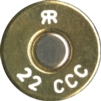The .22 CCC is the same as the .22 PMVF (Powell-Miller Venturi Freebore). With the success of the early Weatherby’s in the 1940’s, Roy Weatherby received a lot of input from wildcatter R.W. Miller, who at that stage was loading the 300 Hoffman Magnum after it was dropped from Western Cartridge Company’s line a few years earlier. Western claimed the steep Hoffman shoulder hiked pressures, and that iven if loaded to acceptable limits, wouldn’t exceed the velocity of the parent .300 Holland.
Miller had the idea to replace the angular neck with a more radiused one, arguing that powder gas would flow more smoothly, directing more energy at the bullet base. This done, he lengthened the throat to reduce pressures as the bullet accelerated. After he wrote letters to The American Rifleman about his work, the magazine sent authority E. Baden Powell out to take a look. Powell advised Miller to straighten the case body, reducing bolt thrust and preventing premature escape of powder gas. The new cartridge was called the PMVF: Powell Miller Venturi Freebore. In 1944 the two men went into business as Vard, Inc. But short of money, they sold in 1945 to Hollywood Tool and Die, which renamed the cartridge CCC: Controlled Combustion Chamberage.


